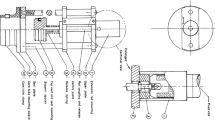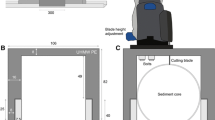Abstract
A convenient, portable, hand-operated surface-sediment sampler for use in shallow water is described. Collection of replicable, undisturbed surface sediment samples from shallow-water locations is made simple. The sampler is highly portable for use at remote sites and can be operated by one person. It is especially useful for sampling in the 0.3–1.3 m water depth range where other samplers are often unsuccessful. This sampler consists of a PVC tube (about 33-cm length, 7.1-cm diameter) attached to a 1-m-long supporting rod. A lever system is used to close off the PVC core tube. In the open position, the core tube is inserted into the sediment to an optimal depth (typically 1-cm) so that a 1-cm disc of surface sediment is enclosed. This disc is then isolated by operating the lever and tube closure plate. The sampler and sediment sample (with an intact epipelon biofilm) are removed carefully so that most of the enclosed water drains away and the sample is retained intact.


Similar content being viewed by others
References
Battarbee RW, Kneen MJ (1982) The use of electronically counted microspheres in absolute diatom analysis. Limnol Oceanogr 27:184–188
Cyr H (1998) How does the vertical distribution of chlorophyll vary in littoral sediments of small lakes? Freshw Biol 40:25–40. doi:10.1046/j.1365-2427.1998.00319.x
Davies OL (1978) The design and analysis of industrial experiments. Longman, London
Douglas MSV, Ludlam S, Feeney S (1996) Changes in diatom assemblages in Lake C2 (Ellesmere Island, Arctic Canada): response to basin isolation from the sea and to other environmental changes. J Paleolimnol 16:217–226. doi:10.1007/BF00176937
Eaton JW, Moss B (1966) The estimation of numbers and pigment content in epipelic algal populations. Limnol Oceanogr 11:584–595
Ekman S (1911) Neue Apparate zur qualitativen und quantitativen Erforschung der Bodenfauna der Seen. Int Rev Hydrobiol 3:553–561. doi:10.1002/iroh.19110030509
Fisher MM, Brenner M, Reddy KR (1992) A simple, inexpensive piston corer for collecting undisturbed sediment/water interface profiles. J Paleolimnol 7:157–161. doi:10.1007/BF00196870
Flower RJ (1985) An improved epilithon sampler and its evaluation in two acid lakes. Br Phycol J 20:109–115. doi:10.1080/00071618500650131
Flower RJ (1986) The relationship between surface sediment diatom assemblages and pH in 33 Galloway lakes—some regression-models for reconstructing pH and their application to sediment cores. Hydrobiologia 143:93–103. doi:10.1007/BF00026650
Flower RJ, Monteith DT, Mackay AW, Chambers JM, Appleby PG (1995) The design and performance of a new box corer for collecting undisturbed samples of soft subaquatic sediments. J Paleolimnol 14:101–111. doi:10.1007/BF00735476
Ford TE (1993) Aquatic microbiology: an ecological approach. Blackwell Scientific Publications, Boston
Glew JR (1991) Miniature gravity corer for recovering short sediment cores. J Paleolimnol 5:285–287. doi:10.1007/BF00200351
Gruendling GK (1971) Ecology of the epipelic algal communities in Marion Lake, British Columbia. J Phycol 7:239–249
Heiri O, Lotter AF, Lemcke G (2001) Loss on ignition as a method for estimating organic and carbonate content in sediments: reproducibility and comparability of results. J Paleolimnol 25:101–110. doi:10.1023/A:1008119611481
Krammer K, Lange-Bertalot H (1997) Bacillariophyceae 1. Teil: Naviculaceae. Gustav Fischer Verlag, Stuttgart
Maitland PS (1969) A simple corer for sampling sand and finer sediments in shallow water. Limnol Oceanogr 14:151–156
Moulton SR II, Kennen JG, Goldstein RM, Hambrook JA (2002) Revised protocols for sampling algal, invertebrate and fish communities as part of the national water-quality assessment program. U.S. Department of the Interior & U.S. Geological Survey, Reston
Mudroch A, MacKnight S (1994) Handbook of techniques for aquatic sediments sampling. Lewis, Boca Raton
Renberg I (1991) The HON-Kajak sediment corer. J Paleolimnol 6:167–170
Renberg I, Hansson H (1993) A pump freeze corer for recent sediments. Limnol Oceanogr 38:1317–1321
Round FE, Crawford RM, Mann DG (1990) The diatoms-biology and morphology of the genera. Cambridge University Press, Cambridge
Acknowledgment
We are grateful to Scottish Natural Heritage for funding the fieldwork. This study was supported by the Dorothy Hodgkin Postgraduate Awards to Hong Yang. We thank Mr. W. Fairman (Civil Engineering UCL) and Mr. Ian Patmore (Geography UCL) for fabricating the sampler. Fieldwork was greatly assisted by support from Forestry Commission staff especially by Mr. N. Grieve, Mr. S. White and Mr. G. Shaw. Mr. James Shilland, Mr. David Hunt, Mr. Ewan Shilland, Dr. Yan Zhao, Dr. Julian Thompson, Mr. Raja Singh, and Dr. Simon Turner all helped with fieldwork. Laboratory work was assisted by Ms. Janet Hope, Mr. Ian Patmore and Ms. Tula Maxted.
Author information
Authors and Affiliations
Corresponding author
Rights and permissions
About this article
Cite this article
Yang, H., Flower, R.J. A portable hand-operated sampler for shallow-water surface sediments with special reference to epipelic communities. J Paleolimnol 42, 317–324 (2009). https://doi.org/10.1007/s10933-008-9278-3
Received:
Accepted:
Published:
Issue Date:
DOI: https://doi.org/10.1007/s10933-008-9278-3




